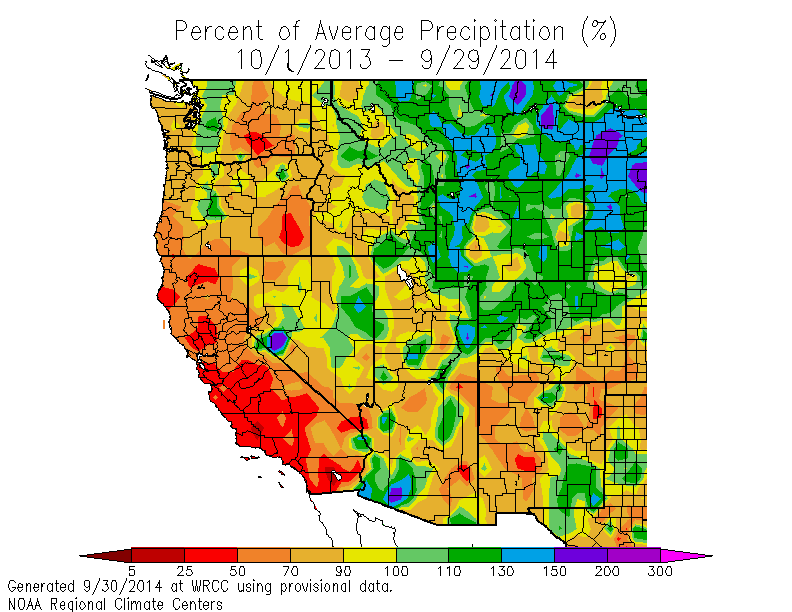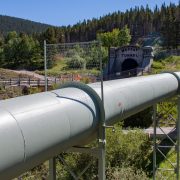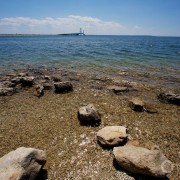Californians Ring In New Water Year with Trepidation
Pervasive fear about consequences of another dry winter.

No champagne bottles or deep-lunged blasts from a noisemaker accompanied the turn of the calendar Wednesday in California. The mood of those dealing with the state’s water crisis is one of enveloping apprehension, not celebration.
October 1 marks the beginning of the water year, a term hydrologists and water managers in the western United States use to define the period when snow begins to accumulate in mountain basins rather than melt. The annual snowpack is the largest reservoir of water in these 17 states. A deep snowpack means ample hydropower generation, plentiful supplies of irrigation water, and cool summer streams for salmon migration. Lack of snow signals a drought – the state of affairs in California for three years now.
By any measure the 2014 water year was a hydrological dud for the nation’s most populous state. Many regions saw less than half the average annual precipitation.
Some watersheds fared better than others, for sure. But none was above average. The northern Sierra Nevada, which feeds the main reservoirs for state and federal canals, received 63 percent of normal precipitation, the seventh-lowest on record for that region.
The southern Sierra Nevada, however, received just half of its normal rain and snow, the third-lowest year on record.
Going by the calendar year – the January to December period that governs most record keeping – 2013 was the driest in state history. Water deliveries from state and federal canals were at record lows. Water stored in the state’s largest reservoirs is just 52 percent of normal for this time of year.
Weather circumstances are not likely to improve in the next three months. The National Weather Service’s Climate Prediction Center forecasts a continuation of drought in California through the end of the year.
Drought Discussions Begin Sooner
State officials are not making weather predictions, but they are approaching the coming year with more forethought.
Mark Cowin, director of the California Department of Water Resources, said that a dry winter and wet winter are equally probable at this point, but the department wants to be better prepared for potential catastrophe than it was ten months ago.
“Last year in January, we did a quick, hurried assessment of potential human health and safety needs across the state,” Cowin told the Metropolitan Water District, the state’s largest municipal water provider, last week. “We want to do a little more diligent planning for the potential impacts and hot spots that we might expect in 2015, so we intend to begin working with all of you on that. We’re also working with state and federal agencies on getting a jump on how we will define the issues and try to reach the balance between water supply and environmental protection, water quality, all of the issues that we worked so hard to balance last year.”
Even with balance, water users will still find themselves in an uncomfortable position if deep snow banks fail to accumulate.
“It will be pretty grim,” Thad Bettner, general manager of Glenn-Colusa Irrigation District, told me. “There are important decisions to be made for the environment – what species to prioritize – and for agriculture and urban users as well.”
The anxiety among those managing the fallout from the drought is evident. When asked about the consequences of another dry winter, managers respond with a thesaurus of gloom: bleak, dire, carnage.
“I don’t want to even think about it,” said Paul Boyer, community development director for Self-Help Enterprises, a Visalia-based group that helps poor families in the Central Valley. The group is one of the leading organizations handling the water crisis in the valley, where thousands of residents are without running water because their wells are not deep enough to access a rapidly shrinking water table.
“We don’t even have the resources to take care of the problem now,” Boyer explained.
Brett writes about agriculture, energy, infrastructure, and the politics and economics of water in the United States. He also writes the Federal Water Tap, Circle of Blue’s weekly digest of U.S. government water news. He is the winner of two Society of Environmental Journalists reporting awards, one of the top honors in American environmental journalism: first place for explanatory reporting for a series on septic system pollution in the United States(2016) and third place for beat reporting in a small market (2014). He received the Sierra Club’s Distinguished Service Award in 2018. Brett lives in Seattle, where he hikes the mountains and bakes pies. Contact Brett Walton







As a centralized problem, it seems that water managers in California are overwhelmed. We may be on the cusp of people finally thinking about water management on a personal level, beyond limiting toilet flushing and showers.
I remember watching the video on this website:
http://enviroscapela.com/rainwater-harvesting-rainwater-harvesting-system-demonstration/
and thinking how the conversion of a swimming pool to a landscape water harvesting project simply makes too much sense.